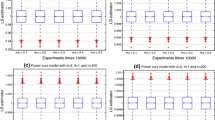Abstract
In this paper, the estimation of a scalar parameter is considered with given lower and upper bounds of the scalar regressor. We derive non-asymptotic, lower and upper bounds on the convergence rates of the parameter estimate variances of the central and the minimax algorithms for noise probability density functions characterized by a thin tail distribution. This presents an extension of the previous work for constant scalar regressors to arbitrary scalar regressors with magnitude constraints. We expect our results to stimulate further research interests in the statistical analysis of these set-based estimators when the unknown parameter is multi-dimensional and the probability distribution function of the noise is more general than the present setup.
Similar content being viewed by others
References
Abramowitz M, Stegun IA (1972) Handbook of mathematical functions with formulas, graphs, and mathematical Tables. vol 55. Applied Mathematics Series, National Bureau of Standards, Washington
Akçay H (2004) The size of the membership-set in a stochastic framework. Automatica 40:253–260
Akçay H, Ninness B (1998) Rational basis functions for robust identification from frequency and time domain measurements. Automatica 34:1101–1117
Akçay H, Hjalmarsson H, Ljung L (1996) On the choice of norms in system identification. IEEE Trans Automat Control 41:1367–1372
At N, Akçay H (2004) Central and projection algorithms in set membership identification with periodic inputs. In: Proceedings of the 43rd IEEE Conference on Decision and Control, Paradise Island, Bahamas, pp 5188–5191
Bai EW (2002) An optimization based robust identification algorithm in the presence of outliers. J Global Optim 23:195–211
Bai EW, Tempo R, Cho H (1995) Membership set estimators: size, optimal inputs, complexity and relations with least squares. IEEE Trans Circuits Syst I: Fundamental Theory Appl 42:266–277
Bai EW, Cho H, Tempo R (1998) Convergence properties of the membership set. Automatica 34:1245–1249
Bai EW, Ye Y, Tempo R (1999) Bounded error parameter estimation: a sequential analytic center approach. IEEE Trans Automat Control 44:1107–1117
Bai EW, Fu M, Tempo R, Ye Y (2000) Convergence results of the analytic center estimator. IEEE Trans Automat Control 45:569–572
Bai EW, Cho HT, Tempo R, Ye YY (2002) Optimization with few violated constraints for linear bounded error parameter estimation. IEEE Trans Automat Control 47:1067-1077
Campi MC, Weyer E (2002) Finite sample properties of system identification methods. IEEE Trans Automat Control 47:1329–1334
Campi MC, Ooi SK, Weyer E (2004) Non-asymptotic quality assessment of FIR models with periodic input. Automat 12:2029–2041
Dahleh MA, Theodosopoulos T, Tsitsiklis JN (1993) The sample complexity of worst-case identification of FIR linear systems. Syst Control Lett 20:157–166
David HA (1981) Order statistics. Wiley, New York
Harrison KJ, Ward JA, Gamble DK (1996) Sample complexity of worst-case identification. Syst Control Lett 27:255–260
Harrison KJ, Partington JR, Ward JA (1998) Complexity of identification of linear systems with rational transfer functions. Math Control Signals and Sysems 11:265–288
Kacewicz B, Milanese M (1995) Optimality properties in finite sample ℓ1 identification with bounded noise. Int J Adapt Control Signal Process 9:87–96
Ljung L (1999) System Identification: theory for the user, 2nd edn. Prentice-Hall, Englewood Cliffs, NJ, USA
Mäkilä PM (1991) Robust identification and Galois sequences. Int J Control 54:1189–1200
Milanese M, Tempo R (1995) Optimal algorithms theory for robust estimation and prediction. IEEE Trans Automat Control 30:730–738
Partington JR (1994) Worst-case identification in ℓ2: linear and non-linear algorithms. Syst Control Lett 22:93–98
Partington JR (1994) Interpolation in normed spaces from the values of linear functionals. Bull London Math Soc 26:165–170
Partington JR, Mäkilä PM (1995) Worst-case analysis of the least-squares method and related identification methods. Syst Control Lett 24:193–200
Poolla K, Tikku A (1994) On the time complexity of worst-case system identification. IEEE Trans Automat Control 39:944–950
Traub JF, Wasilkowski GW, Wozniakowski H (1988) Information based complexity theory. Academic Press, New York
Veres SM, Norton JP (1991) Structure selection for bounded-parameter models: consistency conditions and selection criterion. IEEE Trans Automat Control 36:474–481
Weyer E, Williamson RC, Mareels IMY (1999) Finite sample properties of linear model identification. IEEE Trans Automat Control 44:1370–1383
Author information
Authors and Affiliations
Corresponding author
Rights and permissions
About this article
Cite this article
Akçay, H., At, N. Convergence analysis of central and minimax algorithms in scalar regressor models. Math. Control Signals Syst. 18, 66–99 (2006). https://doi.org/10.1007/s00498-005-0162-7
Received:
Accepted:
Published:
Issue Date:
DOI: https://doi.org/10.1007/s00498-005-0162-7



